




If you’ve ever opened your dishwasher after a full cycle only to find wet dishes and a damp interior, you’re not alone. Many dishwasher owners often encounter this frustrating issue. However, before you call for professional help or consider replacing your dishwasher, there are some simple fixes you can try to resolve the problem.
One of the most common reasons why your dishwasher isn’t drying properly is a malfunctioning or faulty heating element. The heating element is responsible for producing the heat needed to dry your dishes during the final rinse cycle. If it is damaged or not reaching the proper temperature, it can lead to wet dishes. To troubleshoot this issue, you can inspect the heating element for any signs of damage or test its performance using a multimeter.
Another important factor to consider is the use of rinse-aid. Rinse-aid is a liquid detergent that helps to improve the drying process by reducing water spots and creating a sheeting action that allows the water to run off the dishes more easily. If you’re not sure if your dishwasher has a rinse-aid dispenser or if it’s filled, refer to your dishwasher’s manual to locate and inspect this part. Ensuring that the dispenser is clean and filled with rinse-aid can greatly improve the drying performance.
In addition, you should also check the drain for any blockages. A blocked drain can prevent the water from being drained properly, leaving your dishwasher with excess water that can contribute to the lack of drying. Inspect the drain and remove any debris or buildup that may be causing a blockage.
If none of these tips solve the problem, it may be worth considering the age of your dishwasher. Newer dishwashers often incorporate advanced drying technologies, such as convection drying or fan-assisted drying, which can improve the drying performance. If your dishwasher is older and doesn’t have these features, it may be more difficult to achieve completely dry dishes.
These are just a few simple fixes that you can try if your dishwasher isn’t drying properly. Always remember to consult your dishwasher’s manual for specific instructions and helpful tips. By inspecting the heating element, checking the rinse-aid dispenser, and ensuring that the drain is clear, you can improve the drying performance of your dishwasher and enjoy perfectly dry dishes once again.
Why Isn’t My Dishwasher Drying?
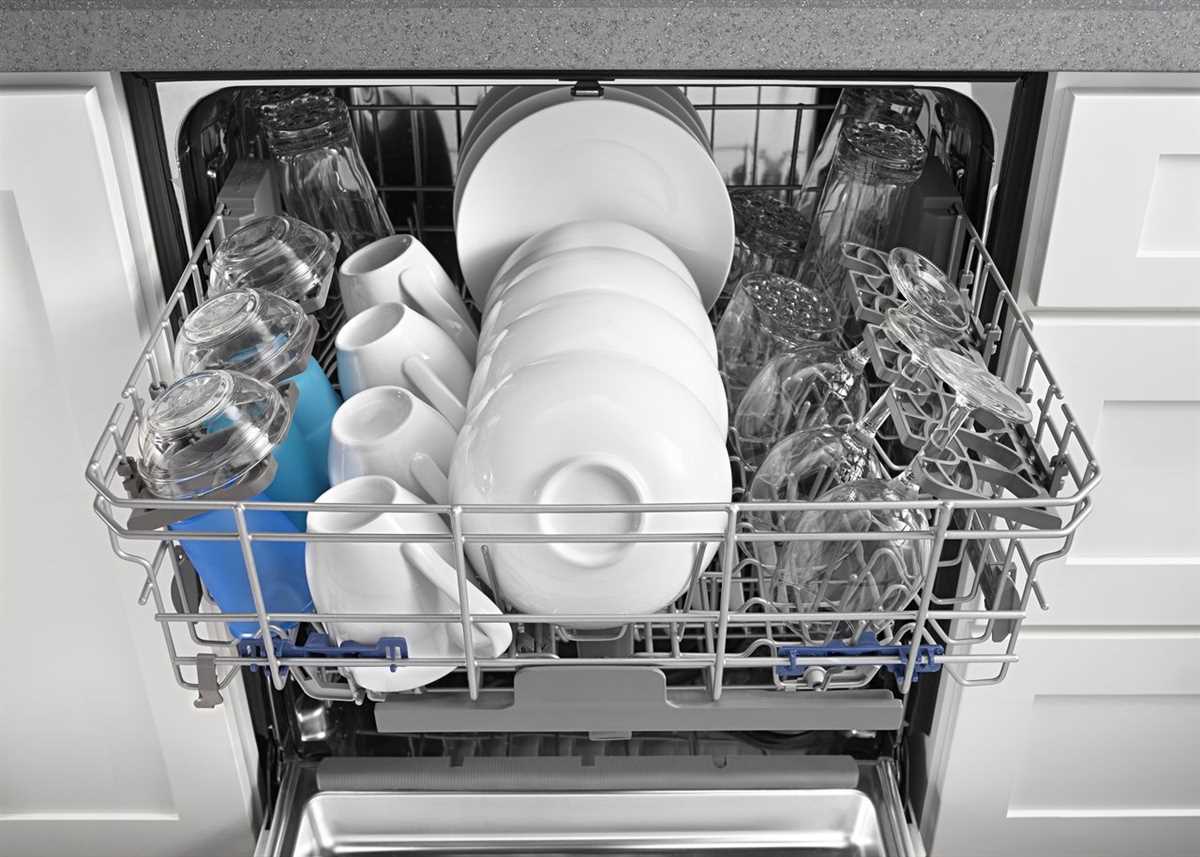
If you’ve been wondering why your dishwasher isn’t drying your dishes properly, there could be several reasons for this problem. In this article, we will explore some common issues that may prevent your dishwasher from drying and offer simple fixes that you can try.
1. Not Enough Heat
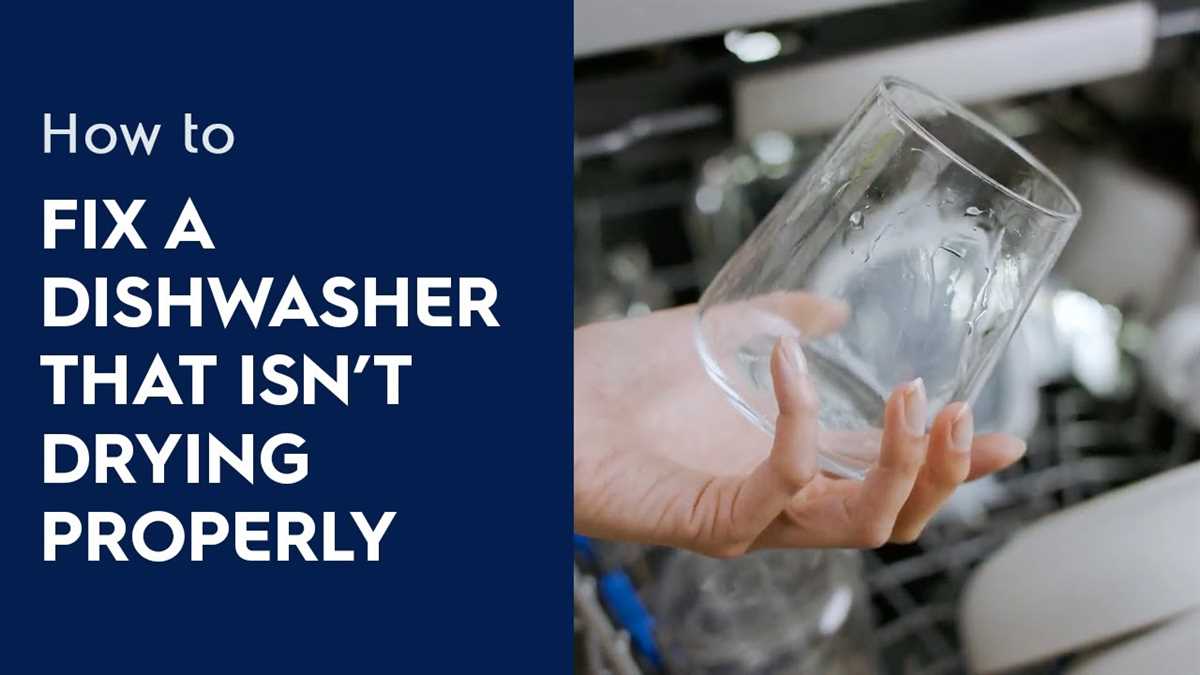
One of the main reasons why your dishwasher may not be drying properly is because it’s not heating up enough during the drying cycle. If the heating element in your dishwasher is damaged or not functioning correctly, it may not generate enough heat to dry your dishes thoroughly.
To determine whether the heating element is the culprit, you can try the following:
- Inspect the heating element visually for any signs of damage or wear.
- Run the dishwasher on a high-temperature cycle and check whether the dishes come out dry.
- Place a thermometer inside the dishwasher during the drying cycle to see if the temperature reaches a suitable level.
If you suspect that the heating element is the problem, it’s best to contact a technician for further inspection and possible replacement.
2. Poor Dish Placement
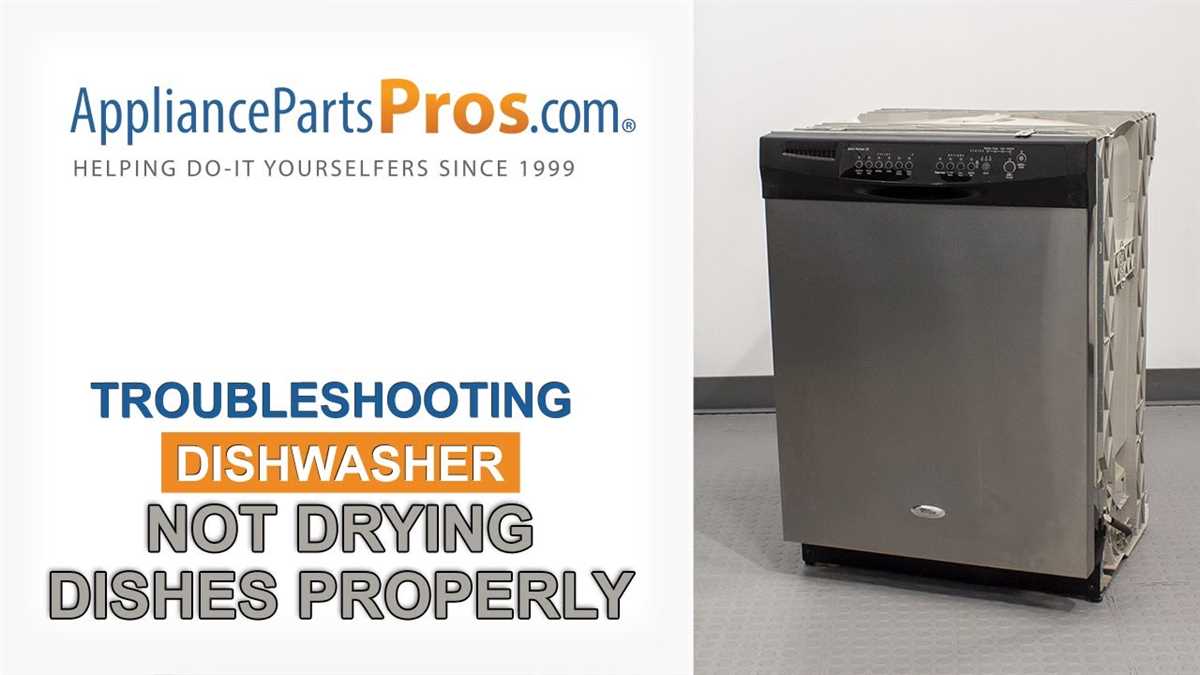
The placement of dishes inside the dishwasher can also impact the drying performance. If your dishes are not arranged properly, water may accumulate in certain spots, preventing proper airflow and drying.
To improve dish placement for better drying:
- Ensure that dishes are spaced apart and not overcrowded.
- Position dishes at an angle, allowing water to run off and air to circulate.
- Place items that are prone to collecting water, such as cups and bowls, upside down.
3. Blocked Vent or Fan
A blocked vent or fan can also hinder the drying process in your dishwasher. If the hot air cannot escape properly, it can lead to condensation and poor drying performance.
To troubleshoot this issue:
- Inspect the vent and fan for any obstructions, such as debris or dirt.
- Clean the vent and ensure it opens and closes easily.
- If necessary, use a needle or toothpick to remove any clogs or blockages.
4. Rinse Aid or Detergent Dispenser
In some cases, the problem may lie with the rinse aid or detergent dispenser. If they are not functioning correctly or if the dispenser is damaged, it can affect the drying performance.
Here are some tips to solve issues with the dispenser:
- Inspect the rinse aid or detergent dispenser for any damage or blockage.
- Clean the dispenser thoroughly and remove any residue or clogs.
- If necessary, replace the dispenser with a new one.
5. Other Causes
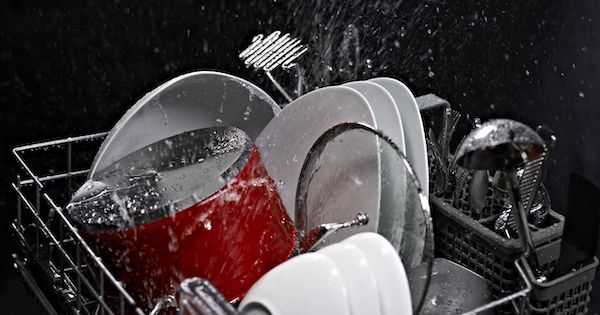
In addition to the above factors, there could be other reasons why your dishwasher isn’t drying properly. This could include issues with the thermostat, a damaged convection heater, or even the water supply itself.
If none of the above solutions solve the problem, it’s recommended to seek assistance from a qualified technician who can diagnose the exact cause and provide an appropriate solution for your specific dishwasher model.
By inspecting and troubleshooting these common causes, you can take steps to improve the drying performance of your dishwasher and say goodbye to water-marked or partially wet dishes for good.
Common Causes of Dishwasher Drying Problems
Dishwashers are a convenient and time-saving appliance in any kitchen. However, if your dishwasher isn’t drying your dishes properly, it can be frustrating and leave you with wet dishes even after a full cycle. Here are some common causes of dishwasher drying problems:
- Vent and High-Limit: One of the most important factors for proper dishwasher drying is the vent and high-limit thermostat. If the vent is blocked or the high-limit thermostat is faulty, the dishwasher may not be able to expel hot and moist air properly, resulting in wet dishes.
- Placement and Loading: The way you place and load your dishes in the dishwasher can also affect the drying process. If dishes are stacked too closely together or items block the vent, air circulation may be limited, preventing proper drying. Be sure to follow the manufacturer’s guidelines for proper dish placement and loading.
- Broken or Damaged Components: Dishwasher drying problems can also be caused by broken or damaged components. Check for any visible signs of damage to the heating element, thermostat, or other related parts. If any components are damaged, they may need to be repaired or replaced.
- Water Temperature and Rinse Aid: The water temperature and the use of rinse aid can also affect the drying performance. Make sure the water temperature is set to the recommended level for your dishwasher model, and ensure that you are using rinse aid to help remove water droplets from the dishes.
- Clogged Spray Arms or Filters: If the spray arms or filters are clogged, they can prevent proper water circulation and affect the drying process. Check and clean the spray arms and filters regularly to ensure they are free from any debris or blockages.
- Improper Cycle Settings: Using the wrong cycle settings can also contribute to dishwasher drying problems. Make sure you are selecting the appropriate cycle for your dishes and the level of cleaning required. Using a shorter, energy-saving cycle may not provide enough time for proper drying.
If you’ve checked all of these common causes and your dishwasher still isn’t drying properly, it may be time to call a repairperson or contact the manufacturer for further assistance. Newer dishwasher models often come with advanced features and sensors to maximize drying performance, so there may be an underlying issue that needs to be addressed by a professional.
Remember, it’s always important to consult your dishwasher’s user manual for specific troubleshooting tips and recommendations for your particular model. By following these tips, you can help ensure that your dishwasher not only cleans but also dries your dishes effectively.
Check the Heating Element and Thermistor
If your dishwasher isn’t drying your dishes properly, the heating element and thermistor are two components you should check to determine the cause of the issue. Here are some steps you can take to troubleshoot and solve the problem:
1. Inspect the Heating Element
First, make sure the heating element isn’t broken or malfunctioning. You can do this by following these steps:
- Turn off the dishwasher and unplug it from the power source.
- Open the dishwasher door and locate the heating element, usually located at the bottom of the dishwasher near the spray arm.
- If the heating element is covered in white mineral deposits, you can clean it by using a soft brush or a needle to remove the buildup. Make sure to wear gloves and follow proper safety precautions.
- After cleaning the heating element, plug the dishwasher back in and run a test cycle to see if the heating element heats up. If it doesn’t, the heating element may need to be replaced.
2. Check the Thermistor
Another component that can affect the drying performance of your dishwasher is the thermistor, which measures the water temperature inside the dishwasher. Here’s what you can do to verify if the thermistor is causing the issue:
- Start by unplugging the dishwasher and turning off the water supply.
- Locate the thermistor, which is usually found near the bottom of the dishwasher tub or on the heating element.
- If the thermistor is clogged or covered in debris, clean it using a soft brush or a needle to ensure proper functioning.
- After cleaning the thermistor, plug the dishwasher back in and turn on the water supply.
- Run a test cycle and make sure the dishwasher heats up properly.
- If the issue persists even after checking the heating element and thermistor, you may need to contact a professional repairperson to diagnose and fix the problem.
By inspecting the heating element and thermistor, you can determine if they are the cause of your dishwasher’s drying performance issues. These simple troubleshooting solutions can help you solve the problem and ensure your dishes come out dry and ready for use again.
Clean the Filter and Sprayer Arms

If your dishwasher isn’t drying your dishes properly, one possible cause is a clogged filter or dirty sprayer arms. Cleaning these components can improve the performance of your dishwasher and ensure that your dishes come out dry and ready to use.
Cleaning the Filter

The dishwasher filter is responsible for trapping food particles and debris, preventing them from recirculating and causing issues with dish cleanliness and drying. Over time, the filter may become clogged, inhibiting proper water flow and preventing the dishwasher from drying dishes effectively.
To clean the filter:
- Locate the filter in the bottom of the dishwasher.
- Remove the filter by twisting or lifting it out, depending on the model.
- Rinse the filter under running water to remove any food particles or debris.
- Use a brush or toothbrush to gently scrub away any stubborn residue.
- Once clean, reinstall the filter in the dishwasher.
Cleaning the Sprayer Arms
The sprayer arms distribute water throughout the dishwasher, ensuring that dishes are thoroughly cleaned and rinsed. If these arms become clogged or dirty, they may not spray water properly, which can affect the drying performance of the dishwasher.
To clean the sprayer arms:
- Remove the sprayer arms by unscrewing or lifting them out, depending on the model.
- Inspect the arms for clogs or debris.
- If clogged, use a needle or toothpick to carefully dislodge the debris from the spray holes.
- Rinse the sprayer arms under running water to remove any remaining debris.
- Once clean, reattach the sprayer arms in their original position.
Regularly cleaning the filter and sprayer arms can help ensure that your dishwasher is functioning properly and that your dishes come out dry. If you’ve tried these cleaning methods and your dishwasher still isn’t drying dishes effectively, there may be other issues at play, such as a malfunctioning heater or thermostat. In such cases, it may be helpful to seek professional assistance or explore other troubleshooting options to resolve the problem.
Ensure Proper Loading and Loading Techniques
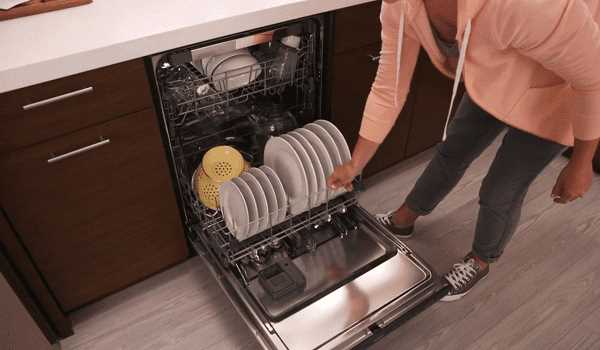
Proper loading and loading techniques are essential for the best drying performance from your dishwasher. During each wash cycle, water needs to drain properly, and if there are any obstructions or incorrect loading techniques, it can affect the drying process. Here are some tips to ensure proper loading:
1. Drain the Dishes Properly
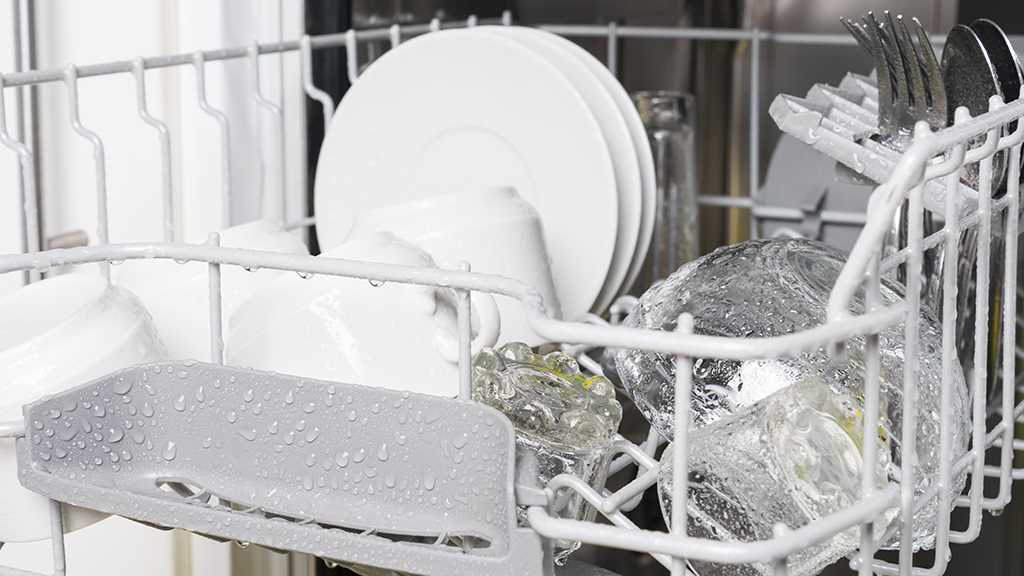
- Before loading your dishwasher, make sure there’s no food or debris left on the dishes. Rinse or scrape off any excess food particles.
- If your dishwasher has a filter, inspect and clean it regularly to prevent clogging and ensure proper drainage.
- Ensure that there’s enough space between the dishes to allow water to circulate effectively.
2. Use Rinse Aid
- Using a rinse aid can help improve the drying performance of your dishwasher.
- Rinse aids reduce water-marked and streaky dishes by helping the water sheet off them, promoting faster drying.
- Make sure to fill up the rinse aid dispenser according to your dishwasher’s manual instructions.
3. Proper Loading Techniques
- Place larger and more heavily soiled items towards the bottom rack, ensuring they are not blocking the spray arms or hindering water circulation.
- Load smaller and delicate items on the top rack to avoid direct contact with the heating element.
- Adjust the racks if possible to accommodate taller items on the bottom rack.
- Do not overload your dishwasher, as overcrowding can prevent proper drying. Leave enough space between items for air to circulate.
4. Check for Mechanical Issues
- If you’ve followed all the above steps and your dishwasher still isn’t drying dishes effectively, there may be a mechanical problem.
- Inspect the heating element, which is responsible for heating the air inside the dishwasher. If it’s broken or faulty, it may need to be replaced.
- Check the door seal to ensure it’s in good condition and properly sealing the dishwasher. A faulty seal can allow moisture to escape during the drying cycle.
- Make sure the dishwasher is getting power. Check the plug and the circuit breaker to confirm that it’s properly connected and receiving electricity.
- Verify that the vent fan is functioning correctly. A faulty vent fan can hinder the evaporation of moisture and cause poor drying performance.
- If you’re unable to determine the problem or if your dishwasher is still under warranty, it’s best to consult a qualified technician or contact the manufacturer for assistance.
5. Test Different Settings
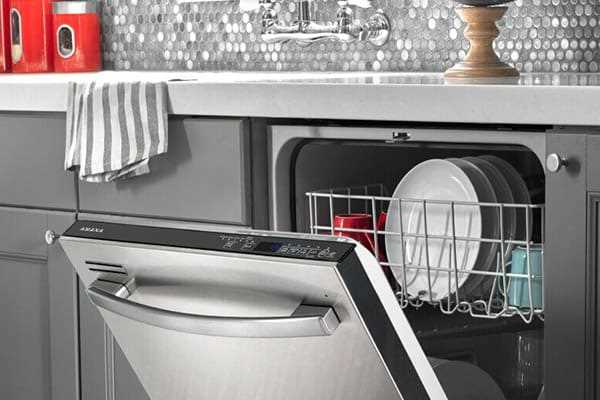
If your dishwasher has multiple wash and dry settings, try experimenting with different combinations to find the optimal setting for drying performance. Some dishwashers have a “Condensation Dry” or “Heated Dry” option; these settings can help improve drying performance.
6. Consider the Age and Model of Your Dishwasher
If your dishwasher is an older model, it may not have the same drying performance as newer appliances.
Some newer dishwashers have advanced features like convection drying or additional drying options that can improve drying results.
If your dishwasher consistently doesn’t dry your dishes adequately, it may be worth considering investing in a new model with better drying capabilities.
By following these suggestions, you can maximize the drying performance of your dishwasher and minimize the chances of water-marked or wet dishes left at the end of each wash cycle.
6 Malfunctioning High-Limit Thermostat
If your dishwasher is not drying properly, one possible culprit could be a malfunctioning high-limit thermostat. This component is designed to prevent the dishwasher from overheating and causing damage by shutting off the heating cycle when the temperature exceeds a certain limit. However, if the high-limit thermostat malfunctions, it may not allow the dishwasher to reach the necessary temperature for proper drying.
Here are some signs that your high-limit thermostat may be faulty:
- Your dishes are not drying even when using rinse-aid or adjusting the drying settings.
- You notice condensation or moisture on the dishes, silverware, or inside the dishwasher after a completed cycle.
- The vent at the bottom of the dishwasher door is not releasing moist air properly.
- The heating element is not getting hot during the drying cycle.
Troubleshooting High-Limit Thermostat Issues
If you suspect a faulty high-limit thermostat, here are some troubleshooting tips you can try:
- Check the high-limit thermostat for any visible signs of damage, such as burnt terminals or a broken wire. If you see any issues, you may need to replace the thermostat.
- Using a multimeter, test the thermostat’s continuity by disconnecting it from the circuit and measuring the resistance between its terminals. If the reading shows infinite resistance, the thermostat is faulty and needs to be replaced.
- If the thermostat passes the continuity test, reinstall it and ensure that there is zero resistance when the thermostat is at its closed position.
- Inspect the vent and make sure it is not blocked or partially blocked. A blocked vent can restrict the airflow and affect the dishwasher’s drying performance.
- Check if the rinse-aid dispenser is functioning properly and adjust its settings if necessary. A lack of rinse-aid can affect drying performance.
- If none of the above solutions work, consider contacting a professional dishwasher repair service to diagnose and fix the issue.
Remember, newer dishwashers may have more advanced drying systems that do not rely solely on the high-limit thermostat. If you are unsure of your dishwasher’s drying system, consult the user manual or contact the manufacturer for further assistance.
By troubleshooting and resolving any issues with the high-limit thermostat, you should be able to improve your dishwasher’s drying performance and ensure that your dishes come out clean and dry after every wash cycle.
FAQ
Why is my dishwasher not drying the dishes properly?
There could be several reasons why your dishwasher is not drying the dishes properly. One common reason is that the heating element may be faulty or not working at its full capacity. Another reason could be that the dishwasher is not getting enough hot water, so you may want to check your hot water supply. Additionally, the dishes may not be properly loaded, blocking the flow of hot air, or the dishwasher may need a thorough cleaning.
What should I do if my dishwasher is not drying properly?
If your dishwasher is not drying properly, you can try a few simple fixes before calling for professional help. First, make sure that there are no items blocking the spray arms and that they can freely rotate. Check and clean the filter to ensure proper water drainage. Also, ensure that the rinse aid dispenser is filled, as this helps with the drying process. If the issue persists, you may want to consider checking the heating element or calling for professional assistance.
Why are my dishes still wet after running the dishwasher?
If your dishes are still wet after running the dishwasher, there might be a few things to consider. Firstly, check if you have selected the right cycle and drying option on your dishwasher. Some cycles have a longer drying time or use higher temperatures. Additionally, check if the rinse aid dispenser is filled, as this helps with drying. Make sure that the dishes are properly placed, allowing hot air to circulate. Lastly, check if the heating element is working properly and not damaged.
How can I improve the drying performance of my dishwasher?
To improve the drying performance of your dishwasher, try these simple tips. Make sure that the rinse aid dispenser is filled as it helps with drying. Properly load the dishes, ensuring that they are not blocking the spray arms or touching each other. Use the correct cycle and drying option on your dishwasher, as some cycles have longer drying times or higher temperatures. Finally, check if the heating element is working properly and consider cleaning the dishwasher if it needs it.
Why are some dishes drying while others remain wet in the dishwasher?
If some dishes are drying while others remain wet in the dishwasher, it could be due to improper loading. Make sure that the dishes are placed in a way that allows hot air to circulate freely. Avoid overcrowding the dishwasher, as this can block the flow of hot air. Additionally, check if the spray arms are not blocked and can rotate freely. If the issue persists, you may want to consider checking the heating element or calling for professional help.












